Yoga can be a great addition to your regular fitness regimen, and even though it’s a total-body practice, your arms are frequently used in supporting roles. They help push your hips up in Downward-Facing Dog Pose, draw your shoulder blades back in Triangle Pose, and balance your body in Chair Pose.
During a yoga practice, it’s common to focus your attention on the deep stretch you feel in your legs, forgetting about the pushing movement in your arms to trigger that stretch. While there are yoga poses that directly target the arms, the biceps, triceps, and shoulders often fall into supporting and stabilizing roles — activating to maintain a pose, but not always acting as a target in poses.
Here, we offer yoga for your arms: poses that either directly or indirectly strengthen your arms so you can feel more stable and controlled throughout your practice.
Why Building Arm Strength in Yoga Is Important
The arms relate to the biceps, triceps, and deltoids — the primary muscles on the humerus, or upper arm bone. While your forearms and wrists play a crucial role in strength and stability for the entire arm, here, we’re looking at these key muscles.
Generally speaking, the biceps pull, the triceps push, and the deltoids are a mixture of push and pull for the purposes of dynamic stability, or keeping your arm straight while the biceps or triceps are engaged. It’s helpful to engage all the parts of the arm to avoid any muscle imbalances. Having strong arms has a host of benefits, regardless of skill level.
For beginner yogis, developing strength in your triceps and shoulders will keep you from feeling fatigued in more rest-oriented postures, such as Downward-Facing Dog Pose. It’s difficult to catch a breather here if your triceps are on fire as you’re pushing your shoulder blades and hips back.
For intermediate to advanced yogis, arm strength will provide a solid base for flying yoga poses or inversions, such as Bakasana (Crane Pose) and Adho Mukha Vrksasana (Handstand). In those poses, the dynamic stability from the deltoid is important. You need your triceps to lift you off the ground, while your shoulders (among other body parts) hold you in place, enabling you to focus mostly on your breathing. You’re likely to encounter bicep strain in Power Yoga classes over more traditional hatha classes, but these muscles are still needed to stabilize the humerus and bring your body back down to the floor gently when exiting a flying or inverted posture.
Yoga Poses to Strengthen Your Biceps
Plank Pose with Row
Why this yoga pose builds arm strength: If you’ve ever taken a Power Yoga class, you’ve likely encountered this variation on Plank. Adding a single-arm row to your pose engages your bicep, deltoid, and upper back to bring the weight to your chest. At the same time, your core and opposite arm are working to keep your body stable as you complete the motion. Technically speaking, you should mostly use your upper back in a row, since your lats and rhomboids are squeezing to pull up, but the biceps are used for support, too.
How to: You’ll need a dumbbell of any weight or a block. Begin by kneeling at the top of your mat in Virasana (Hero’s Pose) with your hands on your props, in line with your shoulders. When you’re ready, press into your props, focusing on keeping your wrists straight, while extending your legs back, hip-width distance apart. Press into the balls of your feet and maintain a flat back. Begin on your right side. To row, exhale and squeeze your right shoulder blade into the centerline of your back while bending your elbow to a 90-degree angle, keeping it tucked by your side. Your hand should be just under your pec muscle. Release on an inhalation by straightening your arm back down to the floor. Repeat on the other side. Do five to 10 reps per side.
Ubhaya Padangusthasana (Big Toe Pose)

Why this yoga pose builds arm strength: While this pose isn’t as strenuous as dumbbell curls, it still requires your biceps to pull against resistance. To get the most benefit for your biceps in this pose, really hone in on the mind-muscle connection. Feel your biceps contracting, even if it’s ever so slight, and that awareness can enable you to generate even more tension and strength in your muscles.
How to: Stand upright with your feet parallel with your mat and hip-width distance apart. On an exhalation, fold forward at your hip joint. Allow your arms to hang, and slide your middle and index fingers between your big toes and second toes, curling your fingers under to grip the big toes. On an exhalation, lift your hips high while pulling on your big toes to keep your torso tucked. Keep your elbows by your sides with a slight bend in them. Hold for three to five breaths, folding and pulling deeper on every exhalation. To exit, release your big toes from your fingers, slide your hands to your hips, and on an inhalation, gently hinge at your hips to rise back up to standing.
Supta Padangusthasana (Reclining Hand-to-Big Toe Pose)
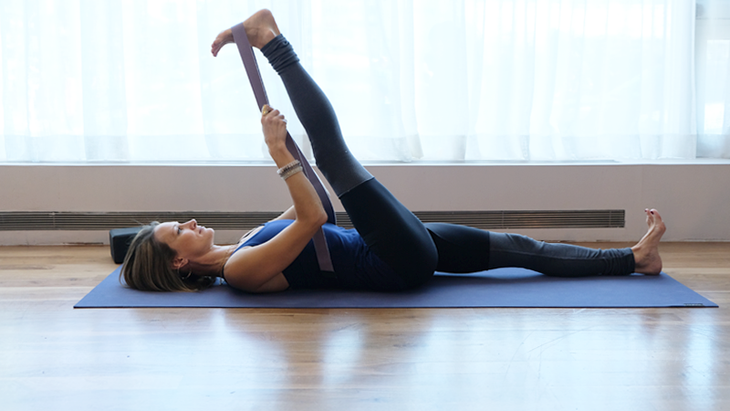
Why this yoga pose builds arm strength: This relatively relaxing pose is another example of the biceps being used indirectly. The pulling motion to bring your toes toward your face shouldn’t be extreme (your hamstrings will let you know if you’re getting too aggressive) but it will still engage the biceps.
How to: Grab a strap, bath towel, or a sweatshirt. Lie on the mat with both legs straight. Exhale and bring a slight bend to your left knee as you, bend your right knee, and bring your right thigh toward your chest. Loop your strap around the arch of your right foot. Inhale and straighten your right knee while pressing your right foot into the strap. Press the shoulder blades firmly into the floor while pulling down on the strap with both hands. Depending on the length of your strap, your arms could either be slightly bent above your chest or have a more 90-degree bend in your elbows with your arms by your sides, wrists straight and upwards. Push through your right heel, while maintaining the slight bend in your left knee. On an inhale, slowly release the pressure, and pull deeper on an exhalation. Hold for 5-10 breaths. To exit, slowly inhale as you lower your right leg to the floor. Repeat on the other side.
Yoga poses to strengthen your triceps
Chaturanga transition
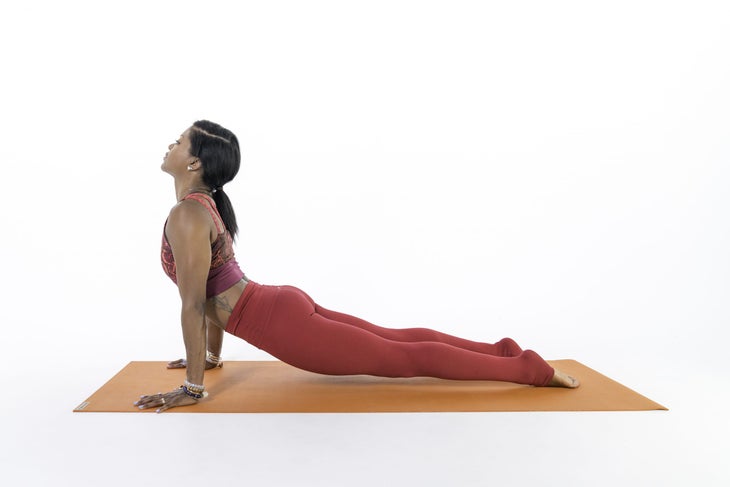
Why this yoga pose builds arm strength: You’ve encountered this flow in Surya Namaskar A, and it definitely wakes up your triceps. Lowering from Plank Pose to Chaturanga Dandasana (Four-Limbed Staff Pose) will get your arms burning, and pressing into Upward- and Downward-Facing Dog Pose requires full extension in your triceps to lift your torso. You could even add in a push-up by lifting back up into Plank from Chaturanga and down again before flowing into Upward-Facing Dog Pose to get more activation in your chest. This right here is all you need for the perfect tricep workout in yoga.
How to: Begin in Plank Pose with your wrists underneath your shoulders, your feet hip-width apart, your legs strong, and your back flat. On an exhale, bend your elbows and lower your chest — keeping your body as straight and stiff as a plank — until your chest is at about a fists-height above the ground. On an inhale, flip your feet so the tops of your feet are on the ground, draw your hips forward, keeping your legs engaged and your knees slightly off the ground, and roll your shoulders back, maintaining a flat chest. On an exhale, come back to the balls of your feet and lift your hips up and back as you press through your hands, coming to Downward-Facing Dog. On an inhale, return to Plank Pose. Repeat for 5–10 cycles.
Bakasana (Crane/Crow Pose)
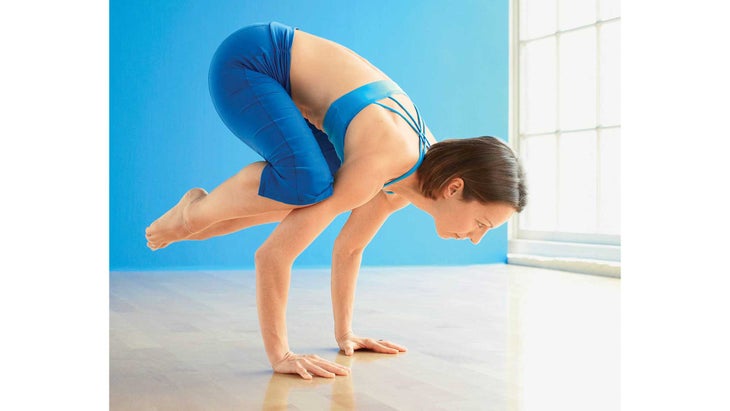
Why this yoga pose builds arm strength: Finding stillness through your breath is the key to this pose, because your triceps are not going to be happy. Your arms are lifting and helping you stabilize your entire body. Press powerfully through your hands to keep yourself elevated.
How to: Squat down from Tadasana (Mountain Pose) with your feet a few inches apart. Separate your knees wider than your hips and lean the torso forward, between the inner thighs. Stretch your arms forward, then bend your elbows, place your hands on the floor and the backs of the upper arms against the shins. Squeeze your inner thighs against the sides of your chest and your shins into your armpits. Lift up onto the balls of your feet and slowly lean forward even more, taking the weight of your torso onto the backs of the upper arms. On an exhalation, lean forward even more onto the backs of your upper arms, to the point where the balls of your feet leave the floor. Now your torso and legs are balanced on the backs of your upper arms. Squeeze the legs against the arms, press the inner hands firmly to the floor and (with an inhalation) straighten the elbows. Keep the head in a neutral position with your eyes looking at the floor, or lift the head slightly, without compressing the back of the neck, and look forward. Stay in the pose anywhere from 20 seconds to 1 minute. To release, exhale and slowly lower your feet to the floor, back into a squat.
Vasisthasana (Side Plank)
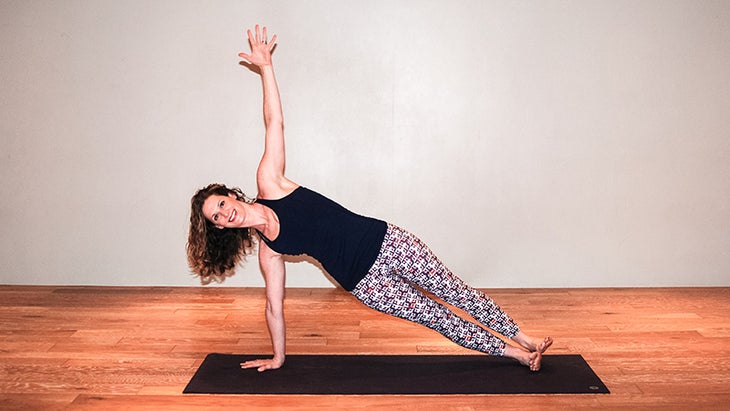
Why this yoga pose builds arm strength: This isometric exercise is perfect for single-arm strengthening. One arm is tasked with keeping your body weight up, while your shoulders are engaged (along with your core) to hold you steady. For a variation, you could even supplement the posture with a press by bending your elbow to lower your side body towards the ground and push yourself back up.
How to: Begin in Plank Pose. Next, move your feet in together and roll onto the outer edge of your right foot, stacking your feet, with the outer edge of your left foot facing the ceiling. Your right hip can swing down to be touching the mat. Bring your left hand to your left hip. On an exhale, press up through your right hand, straightening the elbow and lifting your left hip to make a diagonal line from the outer edge of your left foot all the way across your body to your head. Extend your left arm straight up to the ceiling and pull your shoulder blades toward the center of your back to maintain an open chest. Hold for 20 seconds to 1 minute, then slowly roll back into Plank Pose. Repeat on the other side.
Yoga poses to strengthen your shoulders
Adho Mukha Vrksasana (Handstand)
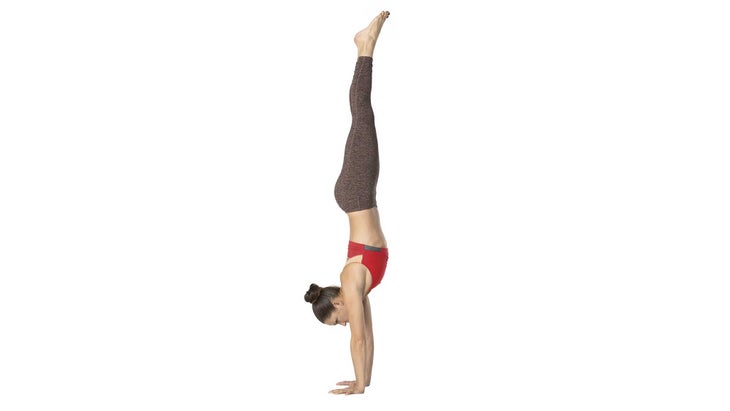
Why this yoga pose builds arm strength: Holding this isometric posture works your entire upper body. Your lats, shoulder girdle, and upper back bare most of the brunt in Handstand, while your triceps and upper chest are engaged to keep you elevated. Your core is even engaged to assist with balance.
How to: Start in Downward-Facing Dog. Bring your feet together at the midline. Press your palms into the mat. Stretch through the sides of the waist and engage your legs. Start to lift your heels, shifting some of your weight into the balls of the feet. Step your right foot forward halfway to your hands and bring your shoulders over your wrists. Allow your right knee to bend. Keep the ball of the right foot on the floor but lift your right heel. Press down firmly through your hands and lift your left leg into Standing Splits. Remember to lift your left inner thigh toward the ceiling and make your leg straight, like an arrow. Wrap your biceps forward. Push firmly down into your hands and make your arms straight. Find a focal point, or drishti, on the ground, a few inches in front of your hands. Keep your arms firm. Bend the right knee deeply and take a small hop off the right foot. It is paramount that as you transition weight onto your hands, you lift up through the inner left thigh (as opposed to reaching the left leg behind you). Draw the low belly in to support the pelvis. Do not aim to get your legs overhead; instead, aim to place your pelvis over your chest and shoulders. Eventually, you will be able to bring the right leg parallel to the floor into an inverted Utthita Hasta Padangusthasana. At this stage, don’t lift the right leg higher—it will serve as an anchor and keep you from flipping over. Once you have the right leg parallel to the floor, internally rotate your thighs, drawing them energetically into your midline. Your legs should feel like scissor blades: bolted firmly into their common point (the pelvis) and moving along, but not away from, the midline. Once you have found balance, draw your legs together. Push down into the hands and actively reach up through the feet and legs. As you hug your legs into the midline, move the tailbone and the tops of the buttocks toward your heels. This will introduce length to the lumbar spine. Draw your low ribs toward your frontal hip bones to prevent any backbending. Make your body feel like an inverted Urdhva Hastasana. Grow even taller by reaching your legs strongly up and away from your rooted and stable palms. Hold for 5 to 8 breaths. To release, step your right foot down, then your left, and take Pada Hastasana (Foot-to-Hand Pose) to stretch the wrists.
Virabhadrasana II (Warrior Pose II)
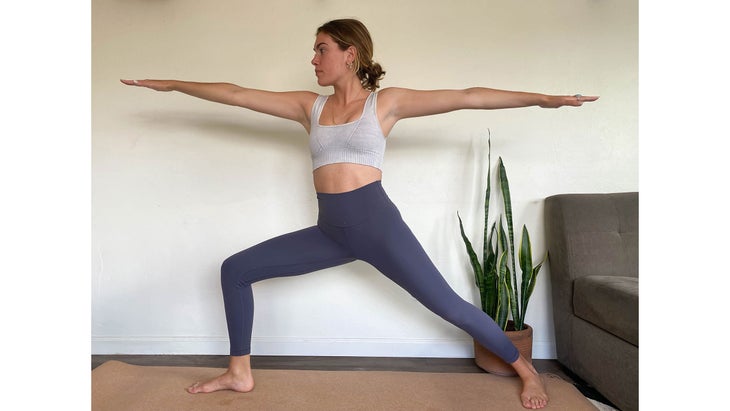
Why this yoga pose builds arm strength: Sometimes gravity is your best means of resistance. Simply holding your arms straight out will get your deltoids firing, resisting the urge to lower your arms back to your sides. The muscles of your rotator cuff are also working to keep your arms firmly outstretched instead of wobbling lower and higher over the course of the pose.
How to: Stand in Tadasana (Mountain Pose). On an exhalation, step your feet to face the long side of your mat. Raise your arms parallel to the floor and reach them actively out to the sides, shoulder blades wide, palms down. Turn your right foot slightly to the right and your left foot out to the left at 90 degrees so your toes are pointing to the short side of the mat. Firm your thighs and turn your left thigh outward Exhale and bend your left knee over the left ankle so your shin is perpendicular to the floor. Press the outer edge of your right foot firmly into the mat. Stretch your arms away from the space between the shoulder blades, parallel to the floor. Don’t lean your chest torso over the left thigh: Keep the sides of the torso equally long and the shoulders directly over the pelvis. Press the tailbone slightly toward the pubis. Turn the head to the left and look out over the fingers. Stay for 30 seconds to 1 minute. Inhale to come up. Reverse the feet and repeat for the same length of time to the left.
Dolphin Pose
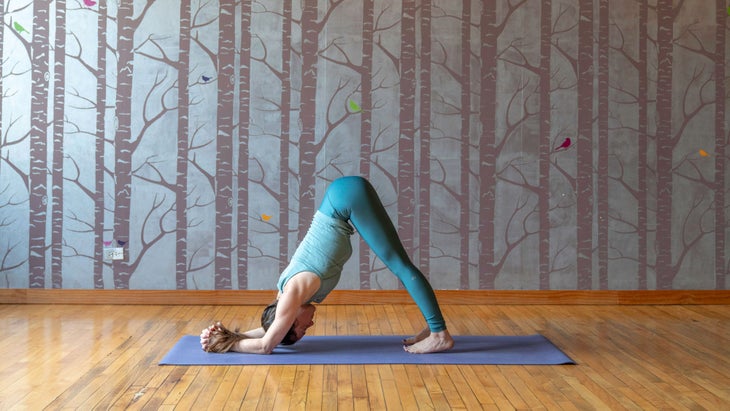
Why this yoga pose strengthens your arms: This pose places a lot of weight in your forearms and shoulders, strengthening them as they act as your foundation. Your shoulder girdle, deltoids, lats, and pecs are all engaged to press your torso up and keep it in the air.
How to: Begin in Tabletop. Lower your forearms onto the mat. Keep your elbows underneath your shoulders as you move your hands together and interlace your fingers with your right thumb on, press through your forearms as you lift your hips back and up, extending through your heels. Keep your legs and back straight. On an inhalation, slowly walk your feet toward your chest. Hold for 20 seconds to 1 minute. To exit, walk your feet back and lower down to your knees.
From Yoga Journal
